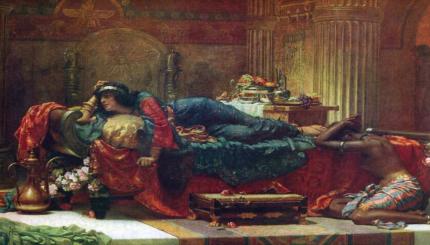The historical Jerusalem of the Hebrew Scriptures symbolizes the orderly civilized life of Israel. Her post-conquest city organization is the opposite pole of the pre-conquest desert culture. Its monarchic regime is set off favorably against the democratic anarchism of the period of the Judges. As we have seen, Mount Zion [in Jerusalem] in many respects is opposed to Mount Sinai [where the Torah was received]. Though Mount Sinai represents the beginning of Israel’s freedom, it also retains as yet the flavor of serfdom in Egyptian bondage, religiously, morally, and politically. Mount Zion and the covenant that God established there with David signify Israel’s sovereignty in its full bloom, in civil and in sacred life.
Since Jerusalem symbolizes orderly civilized life, her destruction spells anarchy. This thesis is borne out by biblical literature. The prophets invariably present the destruction of Jerusalem as the onset of a new chaos and a society in complete disintegration (for example, Isaiah 3).
A Cosmopolitan City
The basic realism of the biblical concept of Jerusalem is further illustrated by the recording of historical circumstances that less fact-minded writers might well have suppressed. Tradition freely admits that Jerusalem was not an Israelite city originally, that it was inhabited by foreigners even at the height of its occupation by the Israelites, and that it originally had served as a sanctuary of foreign cults and continued to serve as such even under many Israelite rulers.
One is almost inclined to suspect that the biblical historiographers put special emphasis on the fact that Jerusalem always had a mixed population, knit into one social network, without making light of individual or group identities. We are told, for example, that Jebusites, from whom David had captured the city, continued to live in it unmolested side by side with the Israelites. Our sources also report at great length that the royal court literally was ridden with foreign warriors–Keretites, Pelethites, Hittites–and advisers, some of whom rose to prominence in the administrative hierarchy of the realm, as for example some of David’s and Solomon’s ministers. These foreign elements apparently were economically and socially fully integrated and in fact became a main pillar of support of the Davidic dynasty.

Help us keep Jewish knowledge accessible to millions of people around the world.
Your donation to My Jewish Learning fuels endless journeys of Jewish discovery. With your help, My Jewish Learning can continue to provide nonstop opportunities for learning, connection and growth.
The resulting melting-pot situation was enhanced by an apparently liberal attitude regarding the admissibility of individuals and groups of foreign ethnic extraction into Jerusalem society. The manifold connections of the tribe of Judah, and especially of the Davidic dynasty, with originally non-Israelite elements is frequently mentioned in biblical traditions. Suffice it here to mention Tamar the Canaanite, who bore two sons to Judah, the eponym of the tribe (Genesis 38), Ruth the Moabite, great-grandmother of David (Ruth 4), and Absalom’s mother, Maacah, a princess of Geshur in Transjordan (II Samuel 3).
Post-exilic Jerusalem
On the other hand, we find especially in prophetic literature a recurring insistence on a future purge of Jerusalem of all foreign elements who have brought pollution into the city. In the days to come, Jerusalem will be inhabited exclusively by people of pure Israelite stock. They will worship in its Temple the one God, the God of Israel. This trend also makes itself strongly felt in postexilic historiography, and it would appear that it is intended to balance the opposite trend, which had prevailed in pre-exilic Israel, as exemplified in early biblical historiography.
In both instances a realistic historical concern seems to be at work, namely, the endeavor to cope with the actual situation and the problems inherent in it. Monarchic Israel, represented by the metropolis Jerusalem, settled with a numerous minority of foreigners, could conceive of no better way of handling the resulting situation than by absorbing those foreigners into Israelite society.
The postexilic community of returnees from the Exile, a mere remnant of the once vigorous nation of early monarchic times, outnumbered many times over by the local population they encountered there, felt forced to segregate themselves from “the peoples of the land” in order to maintain their identity. Jerusalem, purified and holy, thus became the quintessence of a recessionist ideology, which shrank from any contact with those who had not gone through the purifying smelting furnace of the Exile.
Pre-exilic prophecy, indeed, had castigated Jerusalem, its kings, and its inhabitants, because “they abound in customs of the aliens” (Isaiah 2:6). Alliance with foreigners, and with foreign rulers, spelled catastrophe (Isaiah 7:4- 9). Dissociation from other nations was considered the only way of preserving the metropolis and the nation of Israel from disaster.
At the same time, prophecy viewed Jerusalem as the future center of an organized worldwide assembly of nations. In the days to come, Mount Zion, standing for Jerusalem as a whole, will become the goal of pilgrims from all nations: “At that time, they shall call Jerusalem ‘Throne of the Lord,’ and all nations shall assemble there, in the name of the Lord, at Jerusalem” (Jeremiah 3:17; cf. Isaiah 2:2; 60; Micah 4:2). Punishment will be meted out to all peoples on earth that will not go up to Jerusalem to worship the King, Lord of Hosts (Zechariah 14: 17).
From City to Symbol
One is inclined to find here an expression of the significance of Jerusalem at its very peak: the city being raised from the status of the capital of the Israelite kingdom to that of the metropolis of the inhabited ecumene [world]. The vision of Jerusalem as metropolis of the world included, indeed, a portrayal of the future fate of all nations. But first and foremost, it presents Jerusalem as holding promise for every Jew, whether inhabitant of the land of Israel or exiled in a foreign country. The city is expected to become a place of worship for every individual human being, Jew and non-Jew alike. The gloriously humanistic role to be played by the future Jerusalem fired the imagination of early Christian writers who perceived in it the apex of the spiritual development of Israel, crystallized in this noble image of the holy city.
Nonetheless, even in this ethereal portrait of the latter-day Jerusalem, biblical ideology remains earthbound. Late prophets, such as Jeremiah, do not fail to present that ideal Jerusalem in an almost disturbingly realistic fashion: “See, a time is coming–declares the Lord–when the city shall be rebuilt for the Lord from the Tower of Hananel to the Corner Gate; and the measuring line shall go straight out to the Gareb Hill, and then turn to Goah. And the entire Valley of the Corpses and Ashes, and all the fields as far as the Wadi of Kidron, and the comer of the Horse Gate on the east, shall be holy to the Lord. They shall never again be uprooted or overthrown” (Jeremiah 31:38-40).This vision of the future Jerusalem certainly was written by an author who knew the historical Jerusalem and could wish for nothing better than to have it restored in future to its one-time measurements.
Jeremiah’s words throw some light upon yet another factor that has been decisive for the significance that attaches to the city of Jerusalem in Jewish tradition to this very day: it is the entire circumference of the city that is, and will be held, holy. Unlike other religions, which have pinned their pious reverence for Jerusalem on select localities within it that are connected with specific events in their own scriptural historiography, Judaism has sanctified the city as such, and in doing so has kept alive the biblical tradition.
Reprinted with permission of The Gale Group from
Contemporary Jewish Religious Thought
, edited by Arthur A. Cohen and Paul Mendes-Flohr, Twayne Publishers.
Torah
Pronunced: TORE-uh, Origin: Hebrew, the Five Books of Moses.

Help us keep Jewish knowledge accessible to millions of people around the world.
Your donation to My Jewish Learning fuels endless journeys of Jewish discovery. With your help, My Jewish Learning can continue to provide nonstop opportunities for learning, connection and growth.


